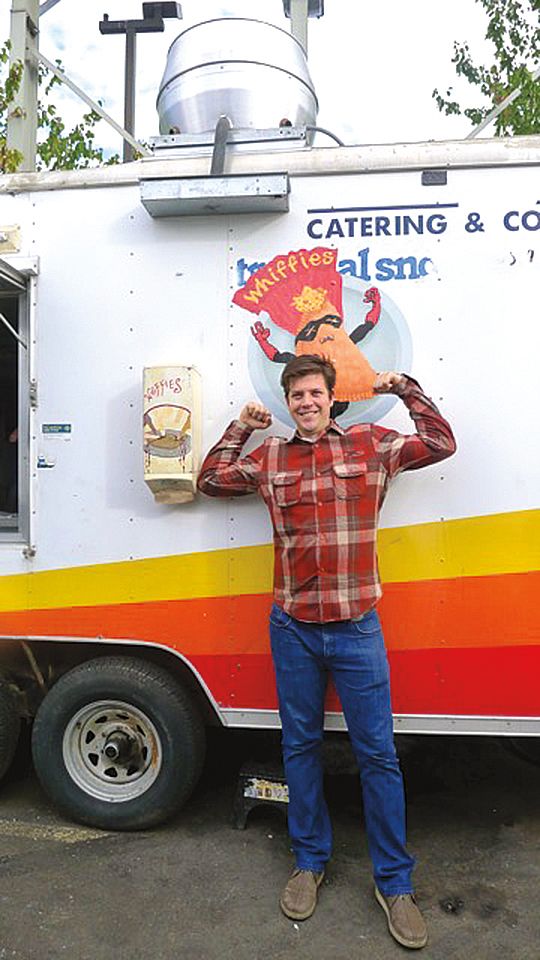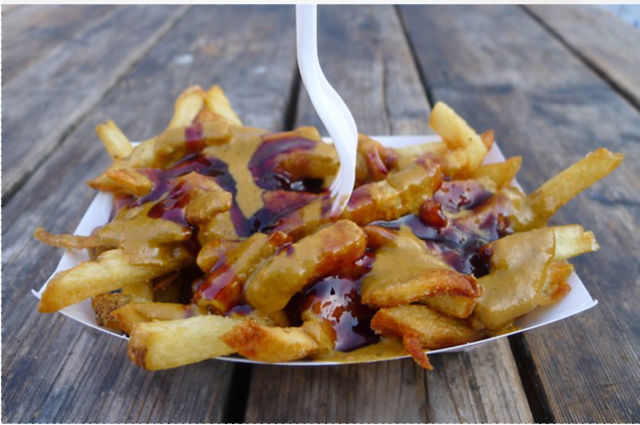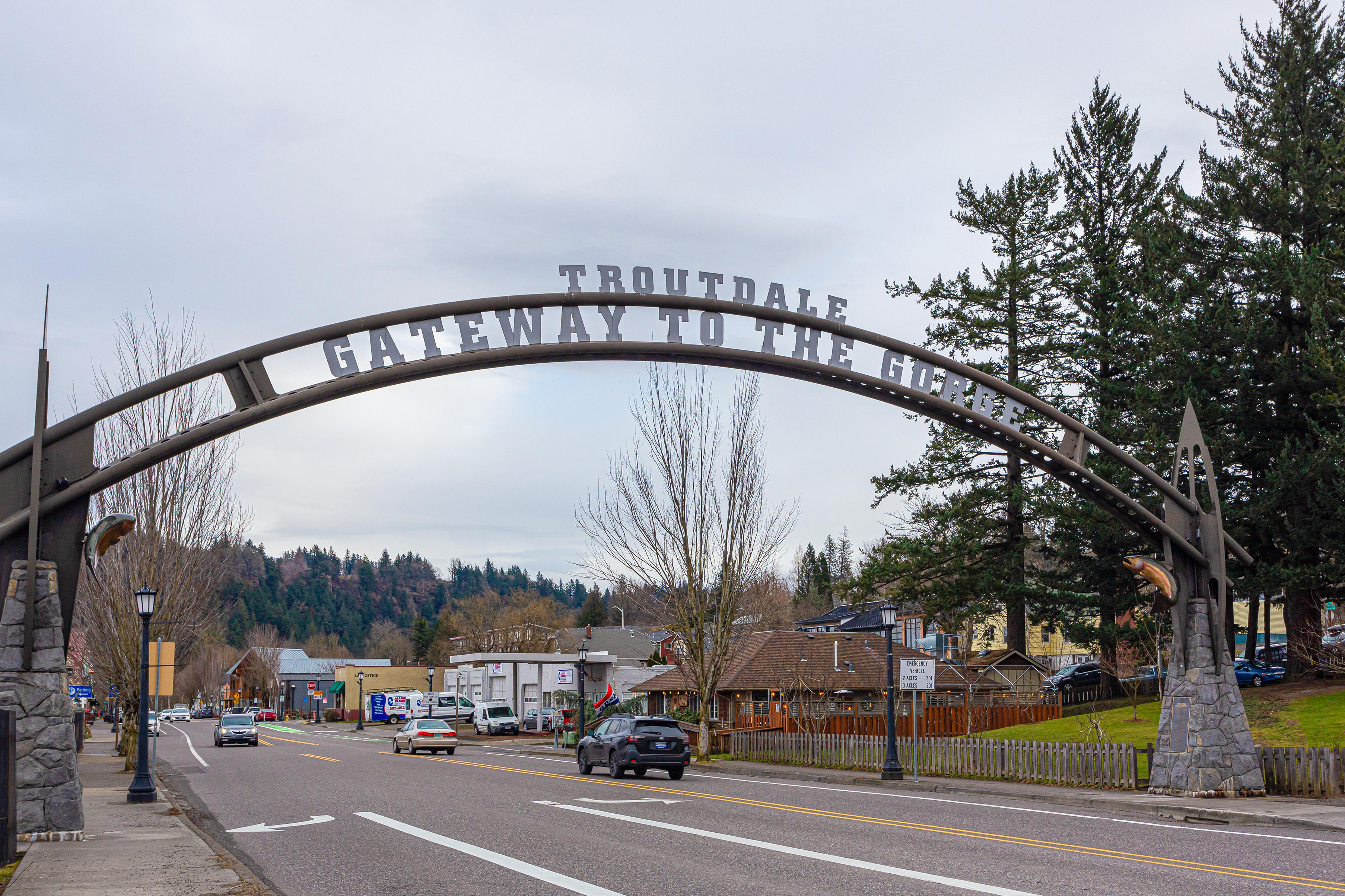How the (Food Cart) Pod People Took Over

Gregg Abbott of Whiffie’s Pie Cart, one of Cartopia’s founding carts in the late-2000s
An excerpt from Karen Brooks’s 2012 book The Mighty Gastropolis: Portland, with Gideon Bosker:
On a snowy night in 2009, the white plastic tent finally caved. For hours, the flimsy sheet struggled valiantly to protect a twisted picnic table, a cluster of tree-trunk stools, and the evening’s host, cart owner Mike McKinnon, the chief decorator, dishwasher, and French fry fanatic behind the Potato Champion. This late-night nosh pit, parked on a half-empty lot in SE Portland, resonated with the underground music community, where McKinnon connected as a drummer. Gregg Abbott, a sometime musician and professional slacker, was also out in the cold. He drifted up to the window for a midnight poutine, a Canadian comfort heap of fries, brown gravy, and cheese curds—a remarkable feast in a neighborhood where good food goes to bed at 10.
McKinnon invited Abbott to warm up inside, and conversation rolled. Abbott, just the wrong side of 30, was tired of parking cars for a living at a steakhouse. The social pressures were coming at him, even in “anything goes” Portland. The question had dogged him for days: What can I do in 90 days to be more than I am? Looking around McKinnon’s cart, he found the answer. “I saw a community piling around this place. Mike wasn’t just one of those guys who stands around doing nothing. He was building something. I felt empowered.”
The next day he called his chef dad for advice and opened a Twitter account to spread the word. His making-of-a-cart communiques caught the ear of bloggers and a growing vegan-tech crowd. Three months later only 25 paces from the Potato Champion, Whiffies Fried Pies opened, with Abbott’s smart-phone army at the window. Even before the first bite of peanut butter cream and chocolate chips oozed from a hot pocket of golden dough, Whiffies had the whiff of a cult hit.
The lure of food trucks seemed irresistible to Portlanders looking for a way to re-enter the American Dream machine. For over a year, from his bedroom vantage point behind the parking lot at Southeast 12th and Hawthorne, construction worker Dustin Knox watched carts come and topple, including the milkshake shack that missed the memo on Portland’s 10-month winter. But one place caught his attention: Potato Champion, a rocking house of Belgian frites, born of craft and obsession, holding vigil until 3 am, and drawing ecstatic club kids. “It was the middle of January. The rain was coming sideways at 1 a.m., and orders for potatoes doubled. I knew I had to open a food cart.”
Knox’s food-world dossier: a dishwashing job at IHOP. No matter. He had a vision: a theatrical crepe cart with renegade combos that could be folded like obsessive laundry into large-format, paper-wrapped packets right before your eyes. He found a relic food wagon at a fairground in Seattle and remodeled it with copper-lined details. Three weeks later, he pulled up his shiny white vehicle next to Potato Champion, filled it with music and gauzy light, and gave it a fancy name, “Perierra Creperie.” From the open storefront-sized window, steam from humongous cast-iron griddles rose like a fog machine; the Notorious B.I.G. rapped so emphatically, the wagon swayed like a hula dancer.
By late April 2009, with dance parties erupting and the blogosphere buzzing,“Cartopia,” the country’s first rock ’n roll food-cart corral was up and positively running. In May, The New York Times showed up. In his “Frugal Portland” piece, writer Matt Gross salivated over the city’s affordable gastronomy and budding street-food scene: “As a New Yorker, I was jealous … overjoyed at what I could find within a single pod.” After that, all hell broke loose. Lines formed before the windows opened. Every night was a party.

Food cart pod pioneer Potato Champion’s signature poutine
“It was a youthful, I don’t give a fuck, let’s put it out there, nothing can stop us moment,” recalls Knox. Cars and customers jostled for supremacy. One night, a dozen women arrived with their own idea: a fold-out table, linen, and candles. With food curated from six carts, they popped open Champagne and staged a guerilla dinner party right then, right there. Knox was struck like Moses at the burning bush. The cars had to go. He built a dozen picnic tables, then laid them out with an invitation to dine communally at the country’s new food-cart table.
The response was swift. On July 4, nearly 1,000 eaters showed in the city’s new living room. With Ghostface Killah’s boom baps in the backdrop, food spilled out of cart windows to a swirl of humanity: black kids and goth girls, drunken frat boys, gay couples, a couple of seniors, a busload of teachers, and a preacher and his son, all eating together, finding friendship and food salvation in a revival tent atmosphere. Even the police came … to eat.
Far from mega-chains, three outcast impresarios reimagined the meeting ground and culinary ethos of Fast Food Nation: an open-air food court and impromptu dance hall feeding the zeitgeist for something cheap, wonderful, and handmade. McKinnon, Abbott, and Knox changed our perspective of what private-public space could be. Nothing quite like it existed anywhere, not in the food-cart worlds of New York, Bangkok, or even downtown Portland, where dedicated food-cart alleys, however interesting, lacked seating and a shared vision.
Thirty-five days after opening, Abbott was a cover boy in The Mercury, a local alternative weekly. Calls came fast and furious from journalists, cart hopefuls, and curious city officials from around the country; Knox delisted his phone number. Everyone who saw the place was equally shocked and smitten. Tourists swelled, The Food Channel knocked, and camera crews became as familiar as take-out boxes. Within a year, Portland’s cart-housing project spread to other neighborhoods, revitalizing forgotten concrete and dirt plots with urban life and budding entrepreneurial dreams.
“Nationally, we made something happen,” says Knox. “People craved an outdoor space that wasn’t corporatized. That image of hundreds of people of all stripes hanging out, talking and eating, wandering around a parking lot strung with lights. It hit on something pop culture didn’t allow. It put ripples through the country.”













